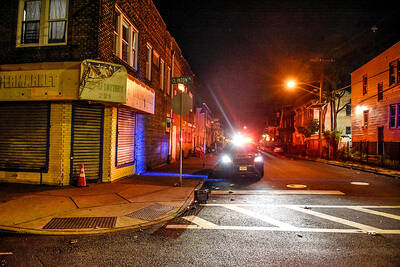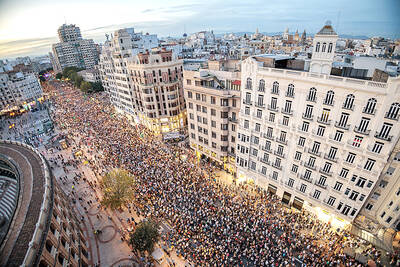A few nights ago, a well-dressed man from the Foreign Ministry walked out on the verandah of the Mamba Point Hotel, ordered a beer, and proceeded to explain what happened here.
The hotel looks out on the Atlantic Ocean, over a beach where many bodies are buried, and into the horizon where three American warships bob in the mist. Here is where the diplomats, aid workers and reporters drawn to the disaster of Liberia gather to discuss, over drinks and dinner, the death and destruction around them.
All of Liberia's troubles, said the man from the ministry, all the death and misery, were the fault of the aborigines.
The aborigines?
The aborigines, said the man from the ministry. When, led by Master Sergeant Samuel Doe, they overthrew the government in 1980, the world turned upside down, the bottom on the top.
A few days later, one of Liberia's most prominent lawyers begged to differ.
"It was the settlers who, in many ways, brought the destruction upon themselves," the lawyer said.
The settlers? The word has a certain resonance in Africa, where most people use it to describe the white Europeans who colonized the continent and created apartheid in South Africa.
The man from the ministry, an urbane descendant of a former president, and the distinguished lawyer, born in a little village without American roots, had divided their nation in two. This divide, they explained, ran so deep that it was like a geologic fault in the earth. It was the source of the wars that have ruined Liberia.
By settlers, the lawyer meant the American Liberians, whose ancestors are the freed slaves who founded this republic in 1847. They have names like Scott, Dennis, Roberts and Payne. They belong to Baptist, Catholic, Episcopal and United Methodist churches, and a dozen other Christian denominations. Some are members of the Masonic Order established here in 1851. Today they represent 4 percent or 5 percent of Liberia's 3 million people.
By aborigines, the man from the ministry meant almost everybody else in Liberia, the people who were here first. They belong to the Kpelle, the Krahn, Kru, Gola and Mandingo tribes, and a dozen others. Half are Christians, a fifth are Muslims. Some follow traditional African rites and religions; some belong to secret societies called Poro and Sande.
The settlers made two sets of laws: a civil law for the civilized, an indigenous law for everyone else.
From 1930 to 1935, the US and Britain broke diplomatic relations with Liberia for its sale of human labor, or slaves, to Spanish colonists in Africa. Civil rights, including the right to vote, were not granted to indigenous Liberians until 1963.
Change came.
"The population was coming together in the 1970s," said Gloria Musu-Scott, 50, the chief justice of the Supreme Court in Liberia. "There was intermarriage. Very few of the settler population could say they had pure blood. Now, I have a lot of respect for them. They came here with nothing and established something. It was like they transported the US to Africa."
Intermarriage did not dissolve disunion. Nor did it solve inequality. "There are very few people who can say, `I'm an American-Liberian'," said Hilary Dennis, 58, president of the nation's biggest shipping company. "The problem has been one of have and have-not."
Those tensions grew as the era of colonialism ended and tribal pride and passions rose against the power of the settler community.
They exploded with a murderous 1980 coup led by an "aborigine," Doe, of the Krahn tribe. The "settler" president, William Tolbert, was killed in his bedroom, and 13 government ministers were tied to telephone poles and shot on the beach.
They raged on as the warlord Charles Taylor began fighting his way to power in 1989 (around that time, Taylor, who has said he is a child of intermarriage, changed his middle name from McArthur to Ghankay, which means "warrior" in Gola).
The tensions never left. Taylor, after bringing 14 years of civil war to Liberia, stepped down as president last month, leaving much of the country in the hands of rebels: Liberians United for Reconciliation and Democracy, a largely Mandingo force backed by Guinea and Ivory Coast, and the Movement for a Democratic Liberia, also backed by Ivory Coast, and dominated by Krahn tribesmen.
"And this is what has led Liberia to self-annihilation," said Musu-Scott, whose court and chambers were sacked by government soldiers three weeks ago. "This is what our selfishness, our lack of nationhood, our lack of compassion for our fellow citizens has brought our country to. This is what we have done for our country. Our existence as a nation is threatened."
The rancor and sadness were banished Saturday night at K.D.'s, an open-air roadhouse on the edge of Monrovia, which reopened two weeks ago. The beer was cold, the barbecue hot. The band began looking for a beat, and found it in a groove somewhere between Nigerian high-life and Jamaican reggae.

DOUBLE-MURDER CASE: The officer told the dispatcher he would check the locations of the callers, but instead headed to a pizzeria, remaining there for about an hour A New Jersey officer has been charged with misconduct after prosecutors said he did not quickly respond to and properly investigate reports of a shooting that turned out to be a double murder, instead allegedly stopping at an ATM and pizzeria. Franklin Township Police Sergeant Kevin Bollaro was the on-duty officer on the evening of Aug. 1, when police received 911 calls reporting gunshots and screaming in Pittstown, about 96km from Manhattan in central New Jersey, Hunterdon County Prosecutor Renee Robeson’s office said. However, rather than responding immediately, prosecutors said GPS data and surveillance video showed Bollaro drove about 3km

Tens of thousands of people on Saturday took to the streets of Spain’s eastern city of Valencia to mark the first anniversary of floods that killed 229 people and to denounce the handling of the disaster. Demonstrators, many carrying photos of the victims, called on regional government head Carlos Mazon to resign over what they said was the slow response to one of Europe’s deadliest natural disasters in decades. “People are still really angry,” said Rosa Cerros, a 42-year-old government worker who took part with her husband and two young daughters. “Why weren’t people evacuated? Its incomprehensible,” she said. Mazon’s

‘MOTHER’ OF THAILAND: In her glamorous heyday in the 1960s, former Thai queen Sirikit mingled with US presidents and superstars such as Elvis Presley The year-long funeral ceremony of former Thai queen Sirikit started yesterday, with grieving royalists set to salute the procession bringing her body to lie in state at Bangkok’s Grand Palace. Members of the royal family are venerated in Thailand, treated by many as semi-divine figures, and lavished with glowing media coverage and gold-adorned portraits hanging in public spaces and private homes nationwide. Sirikit, the mother of Thai King Vajiralongkorn and widow of the nation’s longest-reigning monarch, died late on Friday at the age of 93. Black-and-white tributes to the royal matriarch are being beamed onto towering digital advertizing billboards, on

With much pomp and circumstance, Cairo is today to inaugurate the long-awaited Grand Egyptian Museum (GEM), widely presented as the crowning jewel on authorities’ efforts to overhaul the country’s vital tourism industry. With a panoramic view of the Giza pyramids plateau, the museum houses thousands of artifacts spanning more than 5,000 years of Egyptian antiquity at a whopping cost of more than US$1 billion. More than two decades in the making, the ultra-modern museum anticipates 5 million visitors annually, with never-before-seen relics on display. In the run-up to the grand opening, Egyptian media and official statements have hailed the “historic moment,” describing the